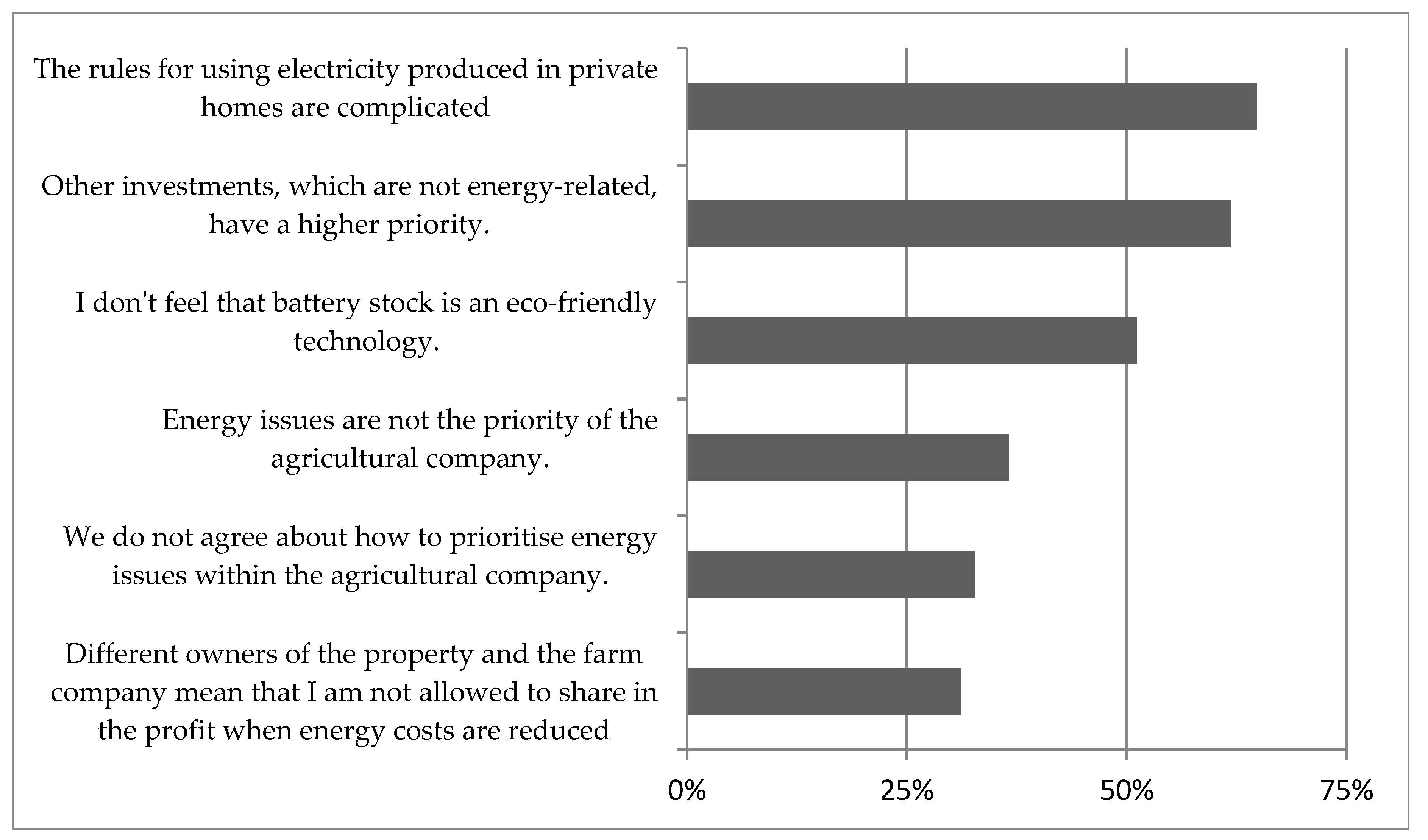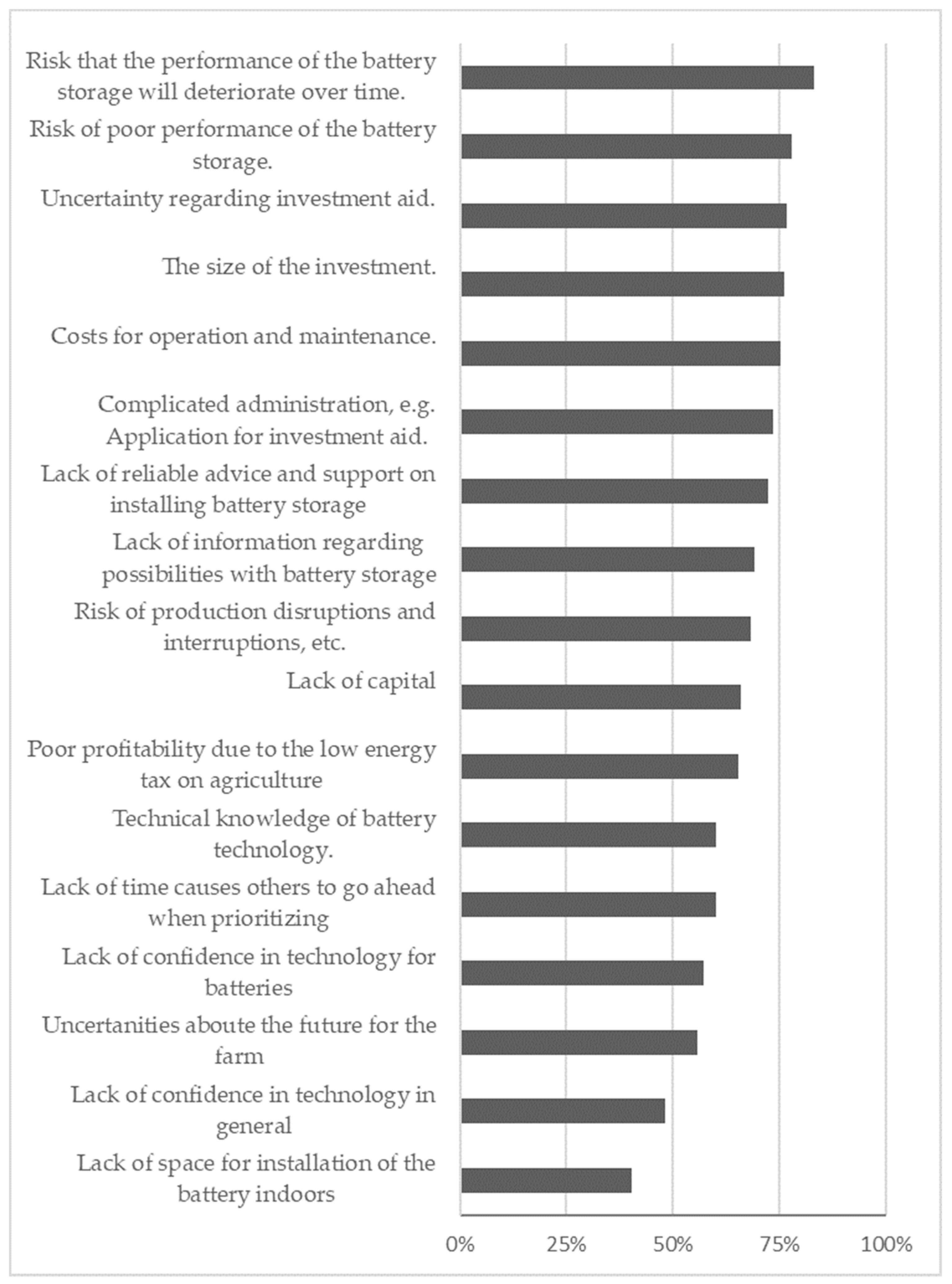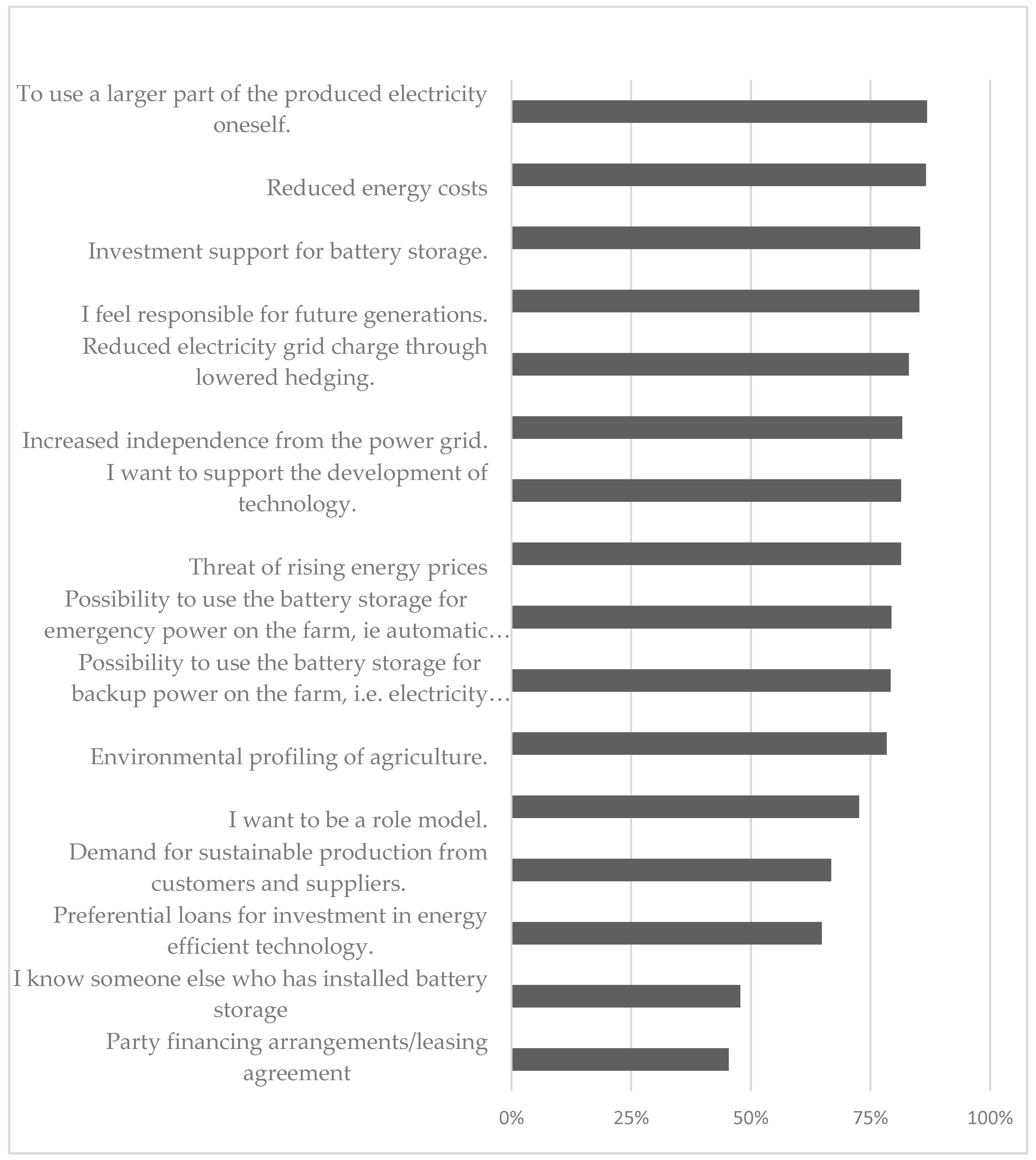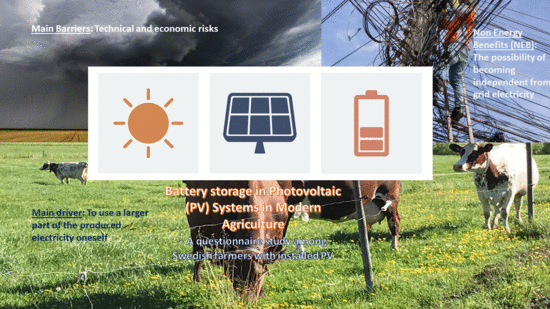Barriers, Driving Forces and Non-Energy Benefits for Battery Storage in Photovoltaic (PV) Systems in Modern Agriculture
Abstract
1. Introduction
- What are the major barriers to battery storage investment in PV systems?
- What are the major drivers to battery storage investment in PV systems?
- What are the major non-energy benefits (NEBs) of battery storage investment in PV systems?
2. Theory, Methods and Data
3. Results and Analysis
3.1. Barriers to Battery Storage Investment in PV Systems
3.1.1. Risk
3.1.2. Lack of Access to Capital
3.1.3. Hidden Costs
3.1.4. Imperfect Information
3.1.5. Values
3.1.6. Low-Ranked Barriers
3.2. Drivers to Battery Storage Investment in PV Systems
3.2.1. Financial Drivers
3.2.2. Environmental Driving Forces
3.3. Non-Energy Benefits from Battery Storage Investment in PV Systems
4. Conclusions
- Risk that the performance of the battery storage will deteriorate over time;
- Risk of poor performance of the battery storage;
- Uncertainty regarding investment aid;
- The size of the investment.
- To use a larger part of the produced electricity by oneself;
- Reducing costs;
- Investment support for battery storage;
- I feel responsible for future generations.
Author Contributions
Funding
Acknowledgments
Conflicts of Interest
Appendix A
- Do you own a farm? ☐ Yes, I am the only owner ☐ Yes, I own a part ☐ No
- Do you live on a farm? ☐ Yes, I live on the farm that I own ☐ Yes, I am leasing the farm ☐ No ☐ Other [Comment]
- Is there a PV plant on your farm? ☐ Yes, I have invested within the farming company ☐ Yes, I have invested for private use, not within the farming ☐ No ☐ No, but we are planning to invest in PV
- 4.
- Is agricultural activity carried out on the farm property that you own and/or live on? ☐ Yes, as main economic activity ☐ Yes, as a secondary occupation ☐ No
- 5.
- What type of business do you conduct in your business? (You can set multiple options.)
☐ Milk production ☐ Goats/Sheep ☐ Feed production ☐ Poultry Production ☐ Production Garden ☐ Grain production ☐ Pig production ☐ Processing food ☐ Contract operations ☐ Nut production ☐ Forestry ☐ Energy ☐ Horses ☐ Crop production ☐ Tourism ☐ Other, namely… [COMMENT FIELDS] - 6.
- How many employees are in the agricultural company (including yourself)? […….] persons
- 7.
- What is the turnover of your agricultural company? ☐ Less than250,000 SEK ☐ 250,000–500,000 SEK ☐ 500,000–1 miljon SEK ☐ 1–2 miljoner SEK ☐ 2–5 miljoner SEK ☐ 5–10 miljoner SEK ☐ över 10 miljoner SEK
- 8.
- Does agriculture have any type of ecolabelling (KRAV, Swedish Sealetc.) ☐ Yes ☐ No Please comment [COMMENT FIELDS]
- 9.
- What year was the farm photovoltaic plant in operation? [COMMENT FIELDS]
- 10.
- Roughly how large the plant is? […] m2 and/or […] kW […] ☐ Do not know
- 11.
- In what main direction is the plant located?☐ East ☐ Southeast ☐ South ☐ Southwest ☐ West
- 12.
- How much electricity does your plant generate in relation to electricity consumption on an annual basis? Disregard that the plant occasionally produces a surplus. ☐ It generates significantly less electricity than the total consumption☐ It generates roughly the same amount of electricity as the total consumption☐ It generates significantly more electricity than the total consumption ☐ Other, namely
- 13.
- What motivated your farm to acquire a photovoltaic plant? [COMMENT FIELDS]
- 14.
- Did you experience any difficulties linked to the construction of the photovoltaic plant? [COMMENT FIELDS]
- 15.
- Do you consider that the photovoltaic plant is a profitable investment? ☐ Yes ☐ No ☐ Partly
- 16.
- Please comment on profitability calculations[COMMENT FIELDS]
- 17.
- What is an acceptable depreciation period for an investment in renewable energy production for your agricultural company? [COMMENT BOX] Year
- 18.
- Is the acceptable depreciation period different to other types of investment? ☐ Yes ☐ NO
- 19.
- Please comment in what way [COMMENT FIELDS]
| Type of Driving Force | Un-Important | Less Important | Neither or | Important | Very Important | Do not Know | |
| 19 | Investment support for battery storage. | ☐ | ☐ | ☐ | ☐ | ☐ | ☐ |
| 20 | I know someone else who has installed battery storage | ☐ | ☐ | ☐ | ☐ | ☐ | ☐ |
| 21 | Party financing arrangements/leasing agreement | ☐ | ☐ | ☐ | ☐ | ☐ | ☐ |
| 22 | Reduced energy costs. | ☐ | ☐ | ☐ | ☐ | ☐ | ☐ |
| 23 | Reduced electricity grid charge through lowered hedging. | ☐ | ☐ | ☐ | ☐ | ☐ | ☐ |
| 24 | Threat of rising energy prices. | ☐ | ☐ | ☐ | ☐ | ☐ | ☐ |
| 25 | To use a larger part of the produced electricity oneself. | ☐ | ☐ | ☐ | ☐ | ☐ | ☐ |
| 26 | Increased independency from the power grid. | ☐ | ☐ | ☐ | ☐ | ☐ | ☐ |
| 27 | Possibility to use the battery storage for backup power on the farm, i.e., electricity supply during longer blackouts. | ☐ | ☐ | ☐ | ☐ | ☐ | ☐ |
| 28 | Possibility to use the battery storage for emergency power on the farm, ie automatic short-term electricity supply | ☐ | ☐ | ☐ | ☐ | ☐ | ☐ |
| 29 | I want to support the development of technology. | ☐ | ☐ | ☐ | ☐ | ☐ | ☐ |
| 30 | I want to be a role model. | ☐ | ☐ | ☐ | ☐ | ☐ | ☐ |
| 31 | I feel responsible for future generations. | ☐ | ☐ | ☐ | ☐ | ☐ | ☐ |
| 32 | Environmental profiling of agriculture. | ☐ | ☐ | ☐ | ☐ | ☐ | ☐ |
| 33 | Demand for sustainable production from customers and suppliers. | ☐ | ☐ | ☐ | ☐ | ☐ | ☐ |
| 34 | I know someone else who has installed battery storage | ☐ | ☐ | ☐ | ☐ | ☐ | ☐ |
| Statement | Takes Full Distance | Takes a Partial Distance | Neither or | Partly Agree | Fully Agree | Do Not Know | |
| 35 | My agriculture has a long-term energy and environmental strategy. | ☐ | ☐ | ☐ | ☐ | ☐ | ☐ |
| 36 | Renewable energy is important in my agriculture. | ☐ | ☐ | ☐ | ☐ | ☐ | ☐ |
| 37 | I think that battery storage seems to be a safe investment. | ☐ | ☐ | ☐ | ☐ | ☐ | ☐ |
| 38 | I think battery storage is an interesting technology solution. | ☐ | ☐ | ☐ | ☐ | ☐ | ☐ |
| 39 | I think battery storage is an environmentally friendly and sustainable way to use more self-produced electricity. | ☐ | ☐ | ☐ | ☐ | ☐ | ☐ |
| 40 | I or someone else in agriculture is interested in new technology solutions. | ☐ | ☐ | ☐ | ☐ | ☐ | ☐ |
| 41 | Investment in a package solution combining solar cells and battery storage is more attractive than two separate investments. | ☐ | ☐ | ☐ | ☐ | ☐ | ☐ |
| Type of Barrier | Un-Important | Less Importantt | Neither or | Important | Very Important | Do Not Know | |
| 42 | Lack of capital | ☐ | ☐ | ☐ | ☐ | ☐ | ☐ |
| 43 | The size of the investment. | ☐ | ☐ | ☐ | ☐ | ☐ | ☐ |
| 44 | Poor profitability due to the low energy tax on agriculture. | ☐ | ☐ | ☐ | ☐ | ☐ | ☐ |
| 45 | Costs for operation and maintenance. | ☐ | ☐ | ☐ | ☐ | ☐ | ☐ |
| 46 | Lack of time causes others to go ahead in prioritization. | ☐ | ☐ | ☐ | ☐ | ☐ | ☐ |
| 47 | Uncertainty regarding investment aid.. | ☐ | ☐ | ☐ | ☐ | ☐ | ☐ |
| 48 | Complicated administration, e.g., Application for investment aid. | ☐ | ☐ | ☐ | ☐ | ☐ | ☐ |
| 49 | Lack of confidence in technology in general | ☐ | ☐ | ☐ | ☐ | ☐ | ☐ |
| 50 | Lack of confidence in technology for batteries | ☐ | ☐ | ☐ | ☐ | ☐ | ☐ |
| 51 | Lack of technical knowledge of battery technology. | ☐ | ☐ | ☐ | ☐ | ☐ | ☐ |
| 52 | Risk of poor performance of the battery storage | ☐ | ☐ | ☐ | ☐ | ☐ | ☐ |
| 53 | Risk that the performance of the battery storage will deteriorate over time. | ☐ | ☐ | ☐ | ☐ | ☐ | ☐ |
| 54 | Risk of production disruptions and interruptions, etc | ☐ | ☐ | ☐ | ☐ | ☐ | ☐ |
| 55 | Lack of space for installation of the battery indoors | ☐ | ☐ | ☐ | ☐ | ☐ | ☐ |
| 56 | Uncertanities aboute the future for the farm | ☐ | ☐ | ☐ | ☐ | ☐ | ☐ |
| 57 | Risk of production disruptions and interruptions, etc | ☐ | ☐ | ☐ | ☐ | ☐ | ☐ |
| 58 | Lack of reliable advice and support on installing battery stock. | ☐ | ☐ | ☐ | ☐ | ☐ | ☐ |
| Statement | Takes Full Distance | Takes a Partial Distance | Neither or | Partly Agree | Fully Agree | Vet ej | |
| 59 | Other investments, which are not energy-related, are higher priority. | ☐ | ☐ | ☐ | ☐ | ☐ | ☐ |
| 60 | Different owners of the property and the farm company mean that I am not allowed to share in the profit when reduced energy costs. | ☐ | ☐ | ☐ | ☐ | ☐ | ☐ |
| 61 | Energy issues are not the priority of the agricultural company. | ☐ | ☐ | ☐ | ☐ | ☐ | ☐ |
| 62 | We do not agree on how to prioritise energy issues within the agricultural company. | ☐ | ☐ | ☐ | ☐ | ☐ | ☐ |
| 63 | The rules for the use of electricity produced in the farm in the private dwelling are complicated. | ☐ | ☐ | ☐ | ☐ | ☐ | ☐ |
| 64 | I don’t think that battery storage is an eco-friendly technology. | ☐ | ☐ | ☐ | ☐ | ☐ | ☐ |
- 65.
- Did you know the ability to install battery storage earlier? [Yes] [No]
- 66.
- If yes, where did you get information about battery storage? Please comment how useful the information has been. [COMMENT FIELDS]
- 67.
- Where did you get information about solar electricity for the installation of the farm’s photovoltaic plant? Please comment how useful the information was for your decision to install solar electricity. [COMMENT FIELDS]
| Statement | Not at all | Some | Neither or | Very | Very Much | Do Not Know | |
| 68 | How prioritized do you think energy and sustainability issues should be in society? | ☐ | ☐ | ☐ | ☐ | ☐ | ☐ |
| 69 | How much responsibility do you think politicians have for energy and sustainability issues? | ☐ | ☐ | ☐ | ☐ | ☐ | ☐ |
| 70 | How much responsibility do you think companies have for energy and sustainability issues. | ☐ | ☐ | ☐ | ☐ | ☐ | ☐ |
| 71 | How much responsibility do you think individuals have for energy and sustainability issues. | ☐ | ☐ | ☐ | ☐ | ☐ | ☐ |
| 72 | How much responsibility do you think agricultural companies generally have for energy and sustainability issues? | ☐ | ☐ | ☐ | ☐ | ☐ | ☐ |
| 73 | How much responsibility do you think your own company is taking for energy and sustainability issues? | ☐ | ☐ | ☐ | ☐ | ☐ | ☐ |
| 74 | How interested is your agricultural company investing in renewable energies? | ☐ | ☐ | ☐ | ☐ | ☐ | ☐ |
- 75.
- How do you think and act on energy and sustainability issues in your agricultural company? [COMMENT FIELDS]
- 76.
- Besides a technical conversion, what do you think is required for sustainable development? [COMMENT FIELDS]
- 77.
- How do you think different actors (e.g., politicians, companies, individuals) should act on energy and sustainability issues? [COMMENT FIELDS]
- 78.
- Born year [COMMENT FIELDS]
- 79.
- Gender ☐ Woman ☐ Man ☐ Other
- 80.
- Do you approve that RISE saves the information you give us in this survey as described above? ☐ Yes ☐ No
- 81.
- Do you have anything further to add regarding barriers and driving forces for investments in solar electricity and/or battery storage? [COMMENT FIELDS]
References
- United Nations. Transforming Our World: The 2030 Agenda for Sustainable Development; Assembly, G., Ed.; United Nations: New York, NY, USA, 2015; Available online: https://undocs.org/A/RES/70/1 (accessed on 17 September 2019).
- Swedish Energy Agency. Energy in Sweden 2018; Swedish Energy Agency: Eskilstuna, Sweden, 2018; Available online: https://www.energimyndigheten.se/en/news/2018/energy-in-sweden---facts-and-figures-2018-available-now/ (accessed on 17 September 2019).
- Swedish Energy Agency. Energy in Sweden 2019; Swedish Energy Agency: Eskilstuna, Sweden, 2019; Available online: https://www.energimyndigheten.se/en/news/2019/energy-in-sweden---facts-and-figures-2019-available-now/ (accessed on 17 September 2019).
- SMHI. Strålningsdata; SMHI: Norrköping, Sweden, 2015; Available online: https://www.smhi.se/kunskapsbanken/meteorologi/solstralning-i-sverige-1.89984 (accessed on 17 September 2019).
- Zsiborács, H.; Baranyai, N.H.; Vincze, A.; Háber, I.; Pintér, G. Economic and Technical Aspects of Flexible Storage Photovoltaic Systems in Europe. Energies 2018, 11, 1445. [Google Scholar] [CrossRef]
- Norberg, I.; Pettersson, O.; Gustavsson, A.; Kovacs, P.; Boork, M.; Ollas, P.; Widén, J.; Lingfors, D.; Marklund, J.; Larsson, D.; et al. Solel i Lantbruket—Realiserbar potential. In Agriculture & Industry; Uppsala, Sweden, 2015; Available online: http://www.diva-portal.org/smash/record.jsf?pid=diva2%3A1062208&dswid=-1633 (accessed on 17 September 2019).
- Lingfors, D.; Widén, J.; Marklund, J.; Boork, M.; Larsson, D. Photovoltaics in Swedish agriculture: Technical potential, grid integration and profitability. In Proceedings of the ISES Solar World Congress 2015 (SWC 2015), Daegu, Korea, 8–12 November 2015; pp. 259–267. Available online: http://proceedings.ises.org/?conference=swc2015 (accessed on 17 September 2019).
- Fitzgerald, G.; Mandel, J.; Morris, J.; Touati, H. The Economics of Battery Energy Storage: How Multi-Use, Customer-Sited Batteries Deliver the Most Services and Value to Customers and the Grid; Rocky Mountain Institute: Boulder, CO, USA, 2015; Available online: https://rmi.org/wp-content/uploads/2017/05/RMI_Document_Repository_Public-Reprts_RMI-TheEconomicsOfBatteryEnergyStorage-ExecutiveSummary.pdf (accessed on 17 September 2019).
- Shaw-Williams, D.; Susilawati, C.; Walker, G. Value of Residential Investment in Photovoltaics and Batteries in Networks: A Techno-Economic Analysis. Energies 2018, 11, 1022. [Google Scholar] [CrossRef]
- Diouf, B.; Pode, R. Potential of lithium-ion batteries in renewable energy. Renew. Energy 2015, 76, 375–380. [Google Scholar] [CrossRef]
- Darcovich, K.; Henquín, E.; Kenney, B.; Davidson, I.; Saldanha, N.; Beausoleil-Morrison, I. Higher-capacity lithium ion battery chemistries for improved residential energy storage with micro-cogeneration. Appl. Energy 2013, 111, 853–861. [Google Scholar] [CrossRef]
- Akinyele, D.; Belikov, J.; Levron, Y. Battery Storage Technologies for Electrical Applications: Impact in Stand-Alone Photovoltaic Systems. Energies 2017, 10, 1760. [Google Scholar] [CrossRef]
- Energikommissionen. Kraftsamling för Framtidens Energi; Stockholm, Sweden, 2017; Available online: http://www.energikommissionen.se/app/uploads/2017/01/sou-2017_2_webb.pdf (accessed on 17 September 2019).
- Mileva, A.; Johnston, J.; Nelson, J.H.; Kammen, D.M. Power system balancing for deep decarbonization of the electricity sector. Appl. Energy 2016, 162, 1001–1009. [Google Scholar] [CrossRef]
- Arif, M.T.; Oo, A.M.T.; Ali, A.B.M.S. Role of Energy Storage on Distribution Transformer Loading in Low Voltage Distribution Network. Smart Grid Renew. Energy 2013, 4, 236–251. [Google Scholar] [CrossRef]
- Jayasekara, N.; Wolfs, P.; Masoum, M.A. An optimal management strategy for distributed storages in distribution networks with high penetrations of PV. Electr. Power Syst. Res. 2014, 116, 147–157. [Google Scholar] [CrossRef]
- Barsali, S.; Giglioli, R.; Lutzemberger, G.; Poli, D.; Valenti, G. Optimised operation of storage systems integrated with MV photovoltaic plants, considering the impact on the battery lifetime. J. Energy Storage 2017, 12, 178–185. [Google Scholar] [CrossRef]
- Luthander, R.; Widén, J.; Munkhammar, J.; Lingfors, D. Self-consumption enhancement and peak shaving of residential photovoltaics using storage and curtailment. Energy 2016, 112, 221–231. [Google Scholar] [CrossRef]
- Luthander, R.; Lingfors, D.; Widén, J.; Munkhammar, J. Preventing overvoltage in a distribution grid with large penetration of photovoltaic power. In Proceedings of the 6th International Workshop on Integration of Solar into Power Systems, Vienna, Austria, 14–15 November 2016; Uta, A., Betancourt, T., Eds.; Energynautics GmbH: Darmstadt, Germany, 2016; pp. 113–118. [Google Scholar]
- Chattopadhyay, D.; Frydas, N.; Kramskaya, T.; Tavoulareas, E. Battery storage in developing countries: Key issues to consider. Electr. J. 2019, 32, 1–6. [Google Scholar] [CrossRef]
- Dehghani-Sanij, A.; Tharumalingam, E.; Dusseault, M.; Fraser, R. Study of energy storage systems and environmental challenges of batteries. Renew. Sustain. Energy Rev. 2019, 104, 192–208. [Google Scholar] [CrossRef]
- Kristoffersson, J.; Norlander, N. Batterilager för Offentliga och Kommersiella Lokaler; Eskilstuna, Sweden, 2018; Available online: https://group.vattenfall.com/se/siteassets/documents/batterilager-for-offentliga-och-kommersiella-lokaler-slutrapport-20181031.pdf (accessed on 17 September 2019).
- Nordling, A.; Englund, R.; Hembjer, A.; och Mannberg, A. Energilagring: Teknik för Lagring av el; Stockholm, Sweden, 2015; Available online: https://www.iva.se/globalassets/info-trycksaker/vagval-el/vagval-el-lagring.pdf (accessed on 17 September 2019).
- Brunisholz, M.; Masson, G.; Kaizuka, I.; Cambiè, C. 2018 Snapshot of Global Photovoltaic Markets; Photvoltaic power systems programme; IEA International Energy Agency: Paris, France, 2018; Available online: http://www.iea-pvps.org/fileadmin/dam/public/report/statistics/IEA-PVPS_-_A_Snapshot_of_Global_PV_-_1992-2017.pdf (accessed on 17 September 2019).
- Hjalmarsson, G. Regeringen Främjar Lagring av Egenproducerad el; Swedish Government: Stockholm, Sweden, 2016; Available online: https://www.regeringen.se/pressmeddelanden/2016/10/regeringen-framjar-lagring-av-egenproducerad-el/ (accessed on 17 September 2019).
- Förordning (2009:689) om Statligt Stöd Till Solceller; The Swedish government offices’ legal databases; Miljö-Och Energidepartementet: Stockholm, Sweden, 2009. Available online: http://rkrattsbaser.gov.se/sfst?bet=2009:689 (accessed on 17 September 2019).
- Förordning (2016:899) om Bidrag Till Lagring av Egenproducerad Elenergi; The Swedish Parliament; Miljö-Och Energidepartementet: Miljö-Och Energidepartementet:, 2016; Available online: https://www.riksdagen.se/sv/dokument-lagar/dokument/svensk-forfattningssamling/forordning-2016899-om-bidrag-till-lagring-av_sfs-2016-899 (accessed on 17 September 2019).
- Skatteverket. Beskattningskonsekvenser för den som har en Solcellsanläggning på sin Jordbruksfastighet; The Swedish Tax Agency: Stockholm, Sweden, 2017; Available online: https://www4.skatteverket.se/rattsligvagledning/365986.html?date=2017-12-20 L (accessed on 17 September 2019).
- Swedish Energy Agency. Elcertifikatsystemet. 2019. Available online: http://www.energimyndigheten.se/fornybart/elcertifikatsystemet/ (accessed on 17 September 2019).
- Nehler, T. A Systematic Literature Review of Methods for Improved Utilisation of the Non-Energy Benefits of Industrial Energy Efficiency. Energies 2018, 11, 3241. [Google Scholar] [CrossRef]
- Jan Trost, O.H. Enkätboken; Studentlitteratur: Lund, Sweden, 2016. [Google Scholar]
- Sorrell, S. The Economics of Energy Efficiency: Barriers to Cost-Effective Investment; Edward Elgar. X: Cheltenham/Northampton, UK, 2004; 349p. [Google Scholar]
- Brudermann, T.; Reinsberger, K.; Orthofer, A.; Kislinger, M.; Posch, A. Photovoltaics in agriculture: A case study on decision making of farmers. Energy Policy 2013, 61, 96–103. [Google Scholar] [CrossRef]
- Thollander, P.; Palm, J. Improving Energy Efficiency in Industrial Energy Systems: An Interdisciplinary Perspective on Barriers, Energy Audits, Energy Management, Policies, and Programs, 1st ed.; Springer: London, UK, 2013; p. 151. [Google Scholar]
- Thollander, P.; Svensson, I.; Trygg, L. Analyzing variables for district heating collaborations between energy utilities and industries. Energy 2010, 35, 3649–3656. [Google Scholar] [CrossRef]
- Yin, R.K. Case Study Research: Design and Methods; Sage publications: Newbury Park, CA, USA, 2017. [Google Scholar]
- Nousdilis, A.I.; Christoforidis, G.C.; Papagiannis, G.K. Active power management in low voltage networks with high photovoltaics penetration based on prosumers’ self-consumption. Appl. Energy 2018, 229, 614–624. [Google Scholar] [CrossRef]
- Von Appen, J.; Braun, M. Interdependencies between self-sufficiency preferences, techno-economic drivers for investment decisions and grid integration of residential PV storage systems. Appl. Energy 2018, 229, 1140–1151. [Google Scholar] [CrossRef]
- Redpath, D.A.; McIlveen-Wright, D.; Kattakayam, T.; Hewitt, N.J.; Karlowski, J.; Bardi, U. Battery powered electric vehicles charged via solar photovoltaic arrays developed for light agricultural duties in remote hilly areas in the Southern Mediterranean region. J. Clean. Prod. 2011, 19, 2034–2048. [Google Scholar] [CrossRef]
- Uski, S.; Rinne, E.; Sarsama, J. Microgrid as a Cost-Effective Alternative to Rural Network Underground Cabling for Adequate Reliability. Energies 2018, 11, 1978. [Google Scholar] [CrossRef]
- Kabir, M.; Mishra, Y.; Ledwich, G.; Xu, Z.; Bansal, R. Improving voltage profile of residential distribution systems using rooftop PVs and Battery Energy Storage systems. Appl. Energy 2014, 134, 290–300. [Google Scholar] [CrossRef]
- Ricardo, J.D.N.; Fthenakis, V.; Hong, C.-Y.; Wang, Y.-C.; Hung, M.-M.; Su, Y.-C.; Tsai, J.-L.; Lin, Y.-C.; Tung, C.-M.; Tsai, M.-A.; et al. A Framework for Comparing the Economic Performance and Associated Emissions of Grid-connected Battery Storage Systems in Existing Building Stock: A NYISO Case Study. In Proceedings of the 2017 IEEE 44th Photovoltaic Specialist Conference (PVSC), Washington, DC, USA, 25–30 June 2017; Volume 4, pp. 3077–3082. [Google Scholar]
- Armaroli, N.; Balzani, V. Towards an electricity-powered world. Energy Environ. Sci. 2011, 4, 3193–3222. [Google Scholar] [CrossRef]
- Rogers, E.M. Diffusion of Innovations, 4th ed.; Free Press: New York, NY, USA, 1995. [Google Scholar]



| Type of Barrier. | Barrier |
|---|---|
| Market failure/ market imperfection | Imperfect information |
| Adverse selection Principal Agent relationship | |
| Split Incentives | |
| Non-market failures | Hidden costs |
| Access to capital | |
| Risk | |
| Heterogeneity | |
| Behavioral | Credibility and trust |
| Bounded rationality | |
| Values | |
| Organizational | Power |
| Culture |
© 2019 by the authors. Licensee MDPI, Basel, Switzerland. This article is an open access article distributed under the terms and conditions of the Creative Commons Attribution (CC BY) license (http://creativecommons.org/licenses/by/4.0/).
Share and Cite
Lane, A.-L.; Boork, M.; Thollander, P. Barriers, Driving Forces and Non-Energy Benefits for Battery Storage in Photovoltaic (PV) Systems in Modern Agriculture. Energies 2019, 12, 3568. https://doi.org/10.3390/en12183568
Lane A-L, Boork M, Thollander P. Barriers, Driving Forces and Non-Energy Benefits for Battery Storage in Photovoltaic (PV) Systems in Modern Agriculture. Energies. 2019; 12(18):3568. https://doi.org/10.3390/en12183568
Chicago/Turabian StyleLane, Anna-Lena, Magdalena Boork, and Patrik Thollander. 2019. "Barriers, Driving Forces and Non-Energy Benefits for Battery Storage in Photovoltaic (PV) Systems in Modern Agriculture" Energies 12, no. 18: 3568. https://doi.org/10.3390/en12183568
APA StyleLane, A.-L., Boork, M., & Thollander, P. (2019). Barriers, Driving Forces and Non-Energy Benefits for Battery Storage in Photovoltaic (PV) Systems in Modern Agriculture. Energies, 12(18), 3568. https://doi.org/10.3390/en12183568






